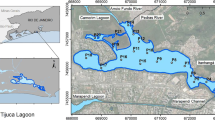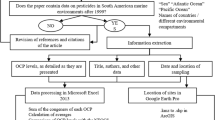Abstract
The PREVIENI project (funded by the Ministry of Environment) investigated the exposure to endocrine disrupters in samples of human population and environmental biota in Italy. The environmental biomonitoring considered two Italian WWF Oasis, with the aim to compare the presence and effects of endocrine disruptors in organisms from two protected natural areas, respectively, upstream and downstream a chemical emission site. Chemical analysis of pollutantsʼ tissue levels was made on tissues from earthworm, barbell, trout, and coot, selected as bioindicator organisms. The contaminants considered were as follows: the perfluorinated compounds perfuoroctane sulfonate (PFOS) and perfluorooctanoic acid (PFOA), polychlorinated biphenyls (PCBs 58 congeners), polybrominated diphenyl ethers (PBDEs, 13 congeners), polycyclic aromatic hydrocarbons (PAHs, 16 compounds), toxic trace elements, the phthalate di-2-ethylexyl phthalate (DEHP) and its primary metabolite, bisphenol A, synthetic musk compounds (musk xylene, musk ketone, tonalide, and galaxolide), and p-nonylphenol. The analyses showed low concentrations of most pollutants in all species from both areas, compared to available literature; noticeable exceptions were the increases of DEHP’s primary metabolite, PBDE, PAHs, Hg, and Pb in barbells, and of PCB and Cd in earthworms from the downstream area. The results showed the presence of endocrine disruptors, including those considered as “non-persistent,” in bioindicators from protected areas, albeit at low levels. The results provide a contribution to the evaluation of reference values in biota from Mediterranean Europe and support the relevance of monitoring exposure to pollutants, in particular for freshwater environment, also in protected areas.



Similar content being viewed by others
References
Albro, P. W., Corbett, J. T., & Schroeder, J. L. (1993). The metabolism of di-(2-ethylhexyl) phthalate in the earthworm Lumbricus terrestris. Comparative Biochemistry and Physiology Part C: Comparative Pharmacology, 104(2), 335–344.
ATSDR. (2005). Toxicology profile for polyaromatic hydrocarbons. ATSDR’s toxicological profiles on CD-ROM. Boca Raton: CRC Press.
Aurigi, S., Focardi, S., Hulea, D., & Renzoni, A. (2000). Organochlorine contamination in bird’s eggs from the Danube delta. Environmental Pollution, 109, 61–67.
Cheng, Z., Nie, X. P., Wang, H. S., & Wong, M. H. (2013). Risk assessments of human exposure to bioaccessible phthalate esters through market fish consumption. Environment International, 57-58, 75–80.
Colles, A., Koppen, G., Hanot, V., Nelen, V., Dewolf, M. C., Noël, E., et al. (2008). Fourth WHO-coordinated survey of human milk for persistent organic pollutants (POPs): Belgian results. Chemosphere, 73, 907–914.
Covaci, A., Gheorghe, A., Hulea, O., & Schepens, P. (2006). Levels and distribution of organochlorine pesticides, polychlorinated biphenyls and polybrominated diphenyl ethers in sediments and biota from the Danube Delta, Romania. Environmental Pollution, 140(1), 136–149.
Eljarrat, E., Labandeira, A., Marsh, G., Raldúa, D., & Barceló, D. (2007). Decabrominated diphenyl ether in river fish and sediment samples collected downstream an industrial park. Chemosphere, 69(8), 1278–1286.
Ernst, G., Zimmermann, S., Christie, P., & Frey, B. (2008). Mercury, cadmium and lead concentrations in different ecophysiological groups of earthworms in forest soils. Environmental Pollution, 156, 1304–1313.
Falandysz, J., Wyrzykowska, B., Puzyn, T., Strandberg, L., & Rappe, C. (2002). PCBs and their congener-specific accumulation in edible fish from the Gulf of Gdansk, Baltic Sea. Food Additives and Contaminants, 19, 779–795.
Fiedler, H. (2003). Dioxins in milk, meat, eggs and fish. In J. P. F. D’Mello (Ed.), Food safety: Contaminants and toxins (pp. 153–174). New York: Cab International Publisher.
Fossi, M. C., Coppola, D., Baini, M., Giannetti, M., Guerranti, C., Marsili, L., et al. (2014). Large filter feeding marine organisms as indicators of microplastic in the pelagic environment: The case studies of the Mediterranean basking shark (Cetorhinus maximus) and fin whale (Balaenoptera physalus). Marine Environmental Research, 100, 17–24.
Giari, L., Guerranti, C., Perra, G., Lanzoni, M., Fano, E. A., & Castaldelli, G. (2015). Occurrence of perfluorooctanesulfonate and perfluorooctanoic acid and histopathology in eels from north Italian waters. Chemosphere, 118, 117–123.
Guerranti, C., & Focardi, S. E. (2011). Differences in POP levels between conventional and omega-3 fatty acid-enriched milk and dairy products. ISRN Toxicology, 2011(2011), 7. http://dx.doi.org/10.5402/2011/541694.
Guerranti, C., Perra, G., Corsolini, S., & Focardi, S. E. (2013a). Pilot study on levels of perfluorooctane sulfonic acid (PFOS) and perfluorooctanoic acid (PFOA) in selected foodstuffs and human milk from Italy. Food Chemistry, 140, 197–203.
Guerranti, C., Sbordoni, I., Fanello, E. L., Borghini, F., Corsi, I., & Focardi, S. E. (2013b). Levels of phthalates in human milk samples from central Italy. Microchemical Journal, 107, 178–181.
Guerranti, C., Baini, M., Casini, S., Focardi, S. E., Giannetti, M., Mancusi, C., et al. (2014). Pilot study on levels of chemical contaminants and porphyrins in Caretta caretta from the Mediterranean Sea. Marine Environmental Research, 100, 33–37.
Guerranti, C., Cau, A., Renzi, M., Badini, S., Grazioli, E., Perra, G., et al. (2016). Phthalates and perfluorinated alkylated substances in Atlantic bluefin tuna (Thunnus thynnus) specimens from Mediterranean Sea (Sardinia, Italy): Levels and risks for human consumption. Journal of Environmental Science and Health, Part B, 51(10), 661–667.
Guo, Y., & Kannan, K. (2012). Challenges encountered in the analysis of phthalate esters in foodstuffs and other biological matrices. Analitical and Bioanalitical Chemistry, 404, 2539–2554.
Herzke, D., Nygard, T., Berger, U., Huber, S., & Rov, N. (2009). Perfluorinated and other persistent halogenated organic compounds in European shag (Phalacrocorax aristotelis) and common eider (Somateria mollissima) from Norway: A suburban to remote pollutant gradient. Science of the Total Environment, 408, 340–348.
Hu, X., Gu, Y., Huang, W., & Yin, D. (2016). Phthalate monoesters as markers of phthalate contamination in wild marine organisms. Environmental Pollution, 218, 410–418.
IZSAM. (2016). Studio di un ecosistema fluviale ad elevato rischio ambientale mediante un approccio olistico basato sull’utilizzo di bioindicatori di diversi livelli nello spettro biologico (pp. 1–104). Teramo: Istituto Zooprofilattico Sperimentale dell'Abruzzo e del Molise http://download.repubblica.it/pdf/2016/cronaca/fluviale.pdf.
Kocagöz, R., Onmus, O., Onat, I., Sıkı, M., & Orhan, H. (2014). Environmental and biological monitoring of persistent organic pollutants in waterbirds by non-invasive versus invasive sampling. Toxicology Letters, 230, 208–217.
La Rocca, C., Tait, S., Guerranti, C., Busani, L., Ciardo, F., Bergamasco, B., et al. (2014). Exposure to endocrine disrupters and nuclear receptors gene expression in infertile and fertile women from different Italian areas. International Journal of Environmental Research and Public Health, 11, 10146–10164.
La Rocca, C., Tait, S., Guerranti, C., Busani, L., Ciardo, F., Bergamasco, B., et al. (2015). Exposure to endocrine disrupters and nuclear receptors gene expression in infertile and fertile men from Italian areas with different environmental features. International Journal of Environmental Research and Public Health, 12, 12425–12445.
Lee, C.-C., Jiang, L.-Y., Kuo, Y.-L., Hsieh, C.-Y., Chen, C. S., & Tien, C.-J. (2013). The potential role of water quality parameters on occurrence of nonylphenol and bisphenol a and identification of their discharge sources in the river ecosystems. Chemosphere, 91, 904–911.
Lee, C.-C., Jiang, L.-Y., Kuo, Y.-L., Chen, C.-Y., Hsieh, C.-Y., Hung, C.-F., et al. (2015). Characteristics of nonylphenol and bisphenol a accumulation by fish and implications for ecological and human health. Science of the Total Environment, 502, 417–425.
Mayer, F. L., Stalling, D. L., & Johnson, J. L. (1972). Phthalate esters as environmental contaminants. Nature, 238, 411–413.
Navarro, I., de la Torre, A., Sanz, P., Pro, J., Carbonell, G., & Martínez, M.,. d.,l., A. (2016). Bioaccumulation of emerging organic compounds (perfluoroalkyl substances and halogenated flame retardants) by earthworm in biosolid amended soils. Environmental Research, 149, 32–39.
Olsson, A., Vitinish, M., Plikshs, M., & Bergman, Å. (1999). Halogenated environmental contaminants in perch (Perca fluviatilis) from Latvian coastal areas. The Science of the Total Environment, 239, 19–30.
Parrish, Z. D., White, J. C., Isleyen, M., Gent, M. P. N., Iannucci-Berger, W., & Eitzer, B. D. (2006). Accumulation of weathered polycyclic aromatic hydrocarbons by plant and earthworm species. Chemosphere, 64, 609–618.
Peijnenburg, W. J., & Struijs, J. (2006). Occurrence of phthalate esters in the environment of The Netherlands. Ecotoxicology and Environmental Safety, 63, 204–215.
Perra, G., Pozo, K., Guerranti, C., Lazzeri, D., Volpi, V., Corsolini, S., et al. (2011). Levels and spatial distribution of polycyclic aromatic hydrocarbons (PAHs) in superficial sediment from 15 Italian marine protected areas (MPA). Marine Pollution Bulletin, 62, 874–877.
Renner, R. (2009). EPA finds record PFOS, PFOA levels in Alabama grazing fields. Environmental Science and Technology, 43, 1245–1246.
Rose, M., Fernandes, A., Mortimer, D., & Baskaran, C. (2015). Contamination of fish in UK fresh water systems: Risk assessment for human consumption. Chemosphere, 122, 183–189.
Safe, S. (1990). Polychlorinated biphenyls (PCBs), dibenzo-p-dioxin (PCDDs), dibenzofurans (PCDFs), and related compounds: Environmental and mechanistic considerations which support the development of toxic equivalency factors (TEFs). Critical Reviews in Toxicology, 21, 51–88.
Schecter, A., Päpke, O., Tung, K. C., Staskal, D., & Birnbaum, L. (2004). Polybrominated diphenyl ethers contamination of United States food. Environmental Science and Technology, 38, 5306–5311.
Schecter, A., Lorber, M., Guo, Y., Wu, Q., Yun, S. H., Kannan, K., et al. (2013). Phthalate concentrations and dietary exposure from food purchased in New York state. Environmental Health Perspectives, 121, 473–479.
Schmid, P., Kohler, M., Gujer, E., Zennegg, M., & Lanfranchi, M. (2007). Persistent organic pollutants, brominated flame retardants and synthetic musks in fish from remote alpine lakes in Switzerland. Chemosphere, 67, S16–S21.
Shao, B., Han, H., Li, D., Zhao, R., Meng, J., & Ma, Y. (2005). Analysis of nonylphenol, octylphenol and bisphenol a in animal tissues by liquid chromatography tandem mass spectrometry with accelerated solvent extraction. Se Pu, 23, 362–365.
US EPA (1996). US EPA method 3545 revision B. Pressurized Fluid Extraction (PFE).
US EPA (1998). US EPA method 6020A (SW-846): Inductively Coupled Plasma-Mass Spectrometry," Revision 1.
Vethaak, A. D., Lahr, J., Schrap, S. M., Belfroid, A. C., Rijs, G. B., Gerritsen, A., et al. (2005). An integrated assessment of estrogenic contamination and biological eVects in the aquatic environment of The Netherlands. Chemosphere, 59, 511–524.
Watanabe, I., & Sakai, S. (2003). Environmental release and behaviour of brominated flame retardants. Environment International, 29, 665–682.
Wei, X., Huang, Y., Wong, M. H., Giesy, J. P., & Wong, C. K. C. (2011). Assessment of risk to humans of bisphenol a in marine and freshwater fish from Pearl River Delta, China. Chemosphere, 85, 122–128.
Acknowledgements
This study was funded by the Italian Environment Ministry (prot n. Q75): Study in model areas on the environmental and health impact of some emerging chemical contaminants (endocrine disrupters), living environment, reproductive outcomes, and repercussions in childhood (PREVIENI) (http://www.iss.it/prvn).
The authors are grateful to all the colleagues of the Department of Physical, Earth and Environmental Sciences of the University of Siena, that gave their help in making the study.
Author information
Authors and Affiliations
Corresponding author
Rights and permissions
About this article
Cite this article
Guerranti, C., Perra, G., Alessi, E. et al. Biomonitoring of chemicals in biota of two wetland protected areas exposed to different levels of environmental impact: results of the “PREVIENI” project. Environ Monit Assess 189, 456 (2017). https://doi.org/10.1007/s10661-017-6165-2
Received:
Accepted:
Published:
DOI: https://doi.org/10.1007/s10661-017-6165-2




